

|
Home Updates Hydros Cars Engines Contacts Links Contact On The Wire |
Frank Jutton and Flash Steam
|
|
The two decades following the end of the second war were a ‘golden age’ in the world of flash steam tethered hydroplanes. Whilst not numerous, there were a hard core of dedicated and innovative enthusiasts continually striving to master this most notoriously fickle of model engineering disciplines. There seemed no limit to the time and ingenuity spent in trying to get flash steam hydroplanes reliable and fast. Amongst them was Frank Jutton who would eventually set a speed record that would take nigh on 20 years and modern technology to beat. Not only did Frank have a career with tethered hydroplanes that spanned well over 50 years, but he also produced one of the most spectacular and radical flash steamers ever seen. In 2010 Frank and his wife Mary very kindly produced this wonderful account of his life an involvement with tethered hydro’s. Details of boats and regattas have been added by OTW |
What started Frank on flash steam?
Frank was bought a Gamages lathe, and rigged it up in the shed at the bottom of the garden. It was driven by an old two-stroke engine, which he was given by the garage owner he worked for. Unfortunately, the noise of the two-stroke was so bad that the neighbours complained, and he had to get an electric motor to take its place. From then on, he made models, which finished up being internal combustion two-stroke engines, which were small enough to go in a model boat and this was what started him off on model boat racing. Frank built several boats with internal combustion engines, but none of them were a big success and so he changed to flash steam. This decision was probably influenced by the better success Bernard Pilliner was having with flash steam. He gradually developed the boats he built until they were fast enough to come in second or third place (except the times when they didn’t finish the course!)
Frank’s background
Frank learned about engines from engineering books/magazines he bought every week. His first job was working in a garage where he initially did repair work, then moved on to "tin bashing" – bodywork, until the war. He then joined the RAF and worked as an engineer in West Africa and India.
The Juttons and Pilliners
Frank and Bernard met when they both joined Guildford Model Powerboat Club before the war; Frank already knew Mary as a friend of his mother. Bernard had an old Rudge motor bike and used to take Frank on the pillion; every now and again the spark plug connection would pull off and Bernard became skilled at reconnecting it while they were still going along! Before the war, the two men would go to meetings at the pond at Stoke Park, Guildford to run their boats, but this stopped when the war began. At this time, Frank was still powering his boats with internal combustion engines, but Bernard never ran anything but flash steamers from the start. Even when they were both running flash steam they were never direct competitors, as Bernard always ran A- Class boats and Frank ran B-Class. There was a very practical reason for this: Frank’s brother Will used to accompany him to regattas and help with the boat in the pond. They would travel on Frank’s motorbike, with Will carrying the boat strapped across his back. A-Class boats were too big and heavy for this, weighing around 16lbs – hence Frank’s choice of B-Class, which weighed about 8lbs.
|
|
The Jutton and Pilliner families continued to be friends, and got together regularly at regattas, until Bernard had to step back in the late 1950s in order to concentrate on the new business he had started up. Enthusiasts would talk very openly and generously at meetings about modifications to their boats and how they overcame various problems. There was no secretiveness, despite the competition – it was as though they were all in it together, trying to push the limits and find out what flash steam could achieve. Left: Frank at St Albans with Mary
Jutton (Pilliner) and Peggy Bamford in 1985 |
Frank remembers conducting one bit of research with Bernard to establish the speed at which air-flow would close the engine cover; this was important to establish at what point to let the boat go when launching, as letting go at the wrong moment could result in the lamps being put out. The experiment involved Frank hanging out of the car window holding Bernard’s boat as he drove along, and logging the speed at which the cover closed. It wasn’t very fast – about 5-10 mph – but it must have been an interesting sight! He also recalls that on occasions when he shared a car with the Pilliners, Mary and Bernard’s children Tony and Loraine, would be trying to tickle him and he would be helpless in the back of the car.
The first flash steam boat Frank made was a flat twin, not very successful, so he went over to a single cylinder engine which greatly improved the performance. It was a very time-consuming hobby and took up all his spare time, but he never found it dull and there was always something new to learn, to try, or to adjust, to get more out of the boat. Sometimes he or Bernard and their families would travel a long distance to a regatta, after weeks of tinkering with their boats, only for the boat to dive or misbehave on the first lap; frustrating but sometimes quite spectacular, and somehow it never put them off. On one occasion Frank and Will travelled all the way to Manchester on his 250cc Velocette, put up at a hotel overnight, and then it poured with rain all the following day so none of the boats were able to run.
It wasn’t unknown for boats to slip their tether on their way round the pond; the marshals found it difficult to stop the public sitting at the water’s edge with their feet in the water, and the prop on a loose boat could be a real hazard. But accidents could also lead to some unlooked-for modifications in design. On one occasion when Frank’s boat came off the line, it hit the bank hard and the impact flattened the nose. He subsequently cut the nose back about 3 inches, making a flat front to it and fitting a brass fuel tank soldered together to fit the new shape, and used that until he build another boat.
It was easy even for engineers to forget the potential dangers of running model boats: Bernard had a much smaller model he had made for Mary and was running it at Southampton Common. Because it was so small, when he wanted to stop it he unthinkingly scooped it up with his hand and it ran up his arm, the prop cutting his thumb badly.
Diversification
In later years, Frank wasn’t only interested in model boats. His friend Bill Maloney, who had started out designing model boats, went on to design full-size power boats. He and Frank built his first design in Bill’s garage in about 1965; it was a Sorcerer and was named ‘Merlin’. They ran power boats together for about four years and Merlin won many national prizes; in fact, Frank can’t recall them ever losing a race. One of the reasons they did so well was their professionalism. While everyone else was having a night out before the race, Frank would be going over the boat from top to tail, ensuring that everything was fully ready for the race.
Frank started building his own boats for water ski-ing and also for sailing in the late 1950s, although he never took up sailing seriously. He continued to run his flash steamer until about 1990.
| The Boats The pond at Stoke Park, Guildford opened in 1937 when Edgar Westbury with ‘Golly’ and Mr Ripper and ‘Happy Days’ put on a demonstration of circular course running. This is probably what inspired Frank and Bernard to start competing. Frank’s first boat was ‘Umph’, which appeared at the Club regatta two years later. The single step hull was reminiscent of the basic Westbury pattern but fitted with an ‘original design of flat-top two-stroke with a rotary inlet valve’. On its very first launch as a new boat, it completed a run, which as ETW put it, ‘though lacking in fireworks, was quite promising for a first run’. Although Frank and Bernard would travel to other regattas, there would be little chance to sort the boats before the outbreak of war and cessation of organised model boating. |
|
When Frank returned to the world of tethered hydroplanes after the war, he joined the flash steam fraternity with the first of the ‘Vesta’ series. This would give him a very quick introduction to the frustrations of running a flash steam hydro. ‘Vesta’ was again a simple single step hull originally with a flat twin motor mounted horizontally in the front of the boat, which was later replaced with a single cylinder uniflow engine. A conventional twin blowlamp heated the boiler tubes contained in a carefully shaped casing. Regatta reports dwell on the problems that Frank had with this boat rather than the successes, including it breaking away and hitting the bank at Victoria Park and Frank being awarded the ‘hard luck prize’ at the Blackheath regatta. There were some good runs with the boat, including one at the International regatta that won him the Crebbin Cup for the first time. Rather than continue with this somewhat outdated hull design though, Frank appeared for the 1948 season with ‘Vesta II’.
|
For ‘Vesta II’ he adopted the more current idea of a step-less hull with two narrow aluminium running planes at the front of the boat, allied to a surface propeller. These planes would soon be changed for much wider and more curved versions. The steam plant was of the same configuration as the earlier boat. At Brockwell Park it was described as a ‘highly interesting boat, which showed great promise’. This was to be something of an understatement as ‘Vesta II’ would establish Frank as one of the most consistent and successful flash steam competitors for many years to come. At the Victoria regatta ‘The event provided more thrills when Mr Jutton with 'Vesta II' set up a record with a speed of 43.95mph’. He could not quite repeat this speed at the International Regatta, but his run would win him the International and see him awarded the Crebbin Trophy for the second time. |
|
|
|
The boat provided the biggest thrill of the day back at Brockwell Park later in the year when after completing one lap it leapt into the air, turned a complete somersault and finished the remaining laps in fine style to win the class. The 1949 season was a very busy one for Frank and Bernard as they attended virtually every regatta in Southern England. ‘Vesta II’ was proving not only relatively reliable for a steamer, but fast as well. At the Grand Regatta Frank beat his own record with a run at 48mph, which would also win him the Crebbin Cup again. |
|
It did not always quite go according to plan though, after a disastrous crash at the Malden regatta left the boat in two parts. A quick repair saw the boat in action again for the International where it managed one slow lap and then two at over 50mph. A full run at 51mph would win Frank the class in the Model Engineer Speedboat competition for the second year as well. It was through a visit to the Guildford regatta that Jim Bamford would become a great friend of Frank’s and be inspired to spend so much time and effort on furthering the progress of flash steam. Right: Vesta II with post-accident modifications to bow. Box by right-hand plane is the silencer. |
|
The successes continued through 1950 and 1951 with ‘Vesta II’ consistently running around the 50mph mark. Hull design was moving on, so for 1952 an entirely new boat was built but still carrying the ‘Vesta’ name.
|
|
‘Vesta III’ was the first of Frank’s boat to feature a hull of semi-circular cross section. It retained the two curved planes at the front rather than sponsons as were becoming the norm. The steam plant was radically different as well. The conventional steam generator and burners were gone to be replaced with a massive circular venturi boiler with flame tube and ‘primus’ type burner that had the vaporising coils inside the boiler casing. With various modifications along the way, this would be the basic design that Frank would persist with, almost to the end of his racing career. |
|
With Bernard Pilliner living on the South Coast and no other hydroplane interest in the Guildford Club, Frank moved to Jim Bamford’s home club Aldershot that ran at Fleet Pond. As well as doing a great deal of experimentation with steamers, Jim also ran IC engines and soon Frank was campaigning a 15cc boat called ‘NIKE’. From its first run in 1956, NIKE was very competitive and for four years Frank would be nip and tuck with the best in the class. In 1958 at Wicksteed Frank broke the 'B' Class record at 66.84mph, but fell foul of a new rule requiring records to be exceeded by more than 1/10th of a second. Right: Frank assisted by John Benson works on NIKE at the Grand Regatta, Victoria Park |
|
As he related in the earlier part of the article, during the 1960s Frank exchanged the racing of tethered boats for the full sized variety, winning the National Class III championship in 1967.
Flash steam was never far away, and when Frank returned to tethered hydro’s it was with another of the ‘fearsome beasts’. Very little is recorded about the performance or details of any of Frank’s boats from then on as they coincided with a period when there were no reports or technical articles in any of the model or boating publications. What information there is has been gleaned from contemporary photographs, personal memories of other competitors and a lot of trawling through archive material.
|
|
On his return, Frank moved to the St Albans club and would run under their banner for some while before joining the Kingfisher Club at Old Ford. From the registration numbers and names has been possible to identify at least four distinct boats over the next two decades, but there may well have been two more, or variations on a theme. With the exception of the very last ‘A’ Class boat, all the others shared similar design principles and layout. |
The first and best known is ‘TNT’. This ‘B’ Class boat used the same semi-circular hull form as the earlier ‘Vesta III’ but now with the motor in the stern and the venturi boiler in the front. It is believed that ‘TNT’ was so named due to the ‘popping’ of the vaporised fuel in the boiler casing. The most obvious feature and the one that would make both Frank’s and Jim Bamford’s boats so effective was the propshaft being extended out of the transom on an outrigger system, similar to the Arneson drive later used on virtually every offshore powerboat to the present day. With the two aluminium planes at the bow and the surface prop way behind the boat, there was almost nothing touching the water other than the tip of one prop blade.
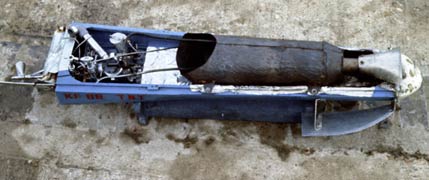 |
|
The ‘B’ Class had a very restrictive weight limit of 8lbs, yet at Woburn on 29th October 1972, Frank and ‘TNT’ would produce a run of 69.58mph, which took the outright steam record as well as the class record. The level of Frank’s achievement can be measured by the fact that the outright record would last until 1980 when Bob Kirtley broke it for the first of many times with a much bigger and newer ‘A’ Class boat. The ‘B’ Class record however, remained intact until 1991 when Olly Monk and his state of the art ‘Floyd II added another 10mph.
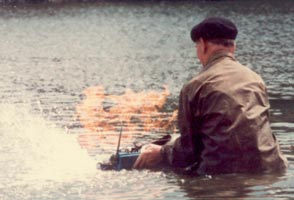 |
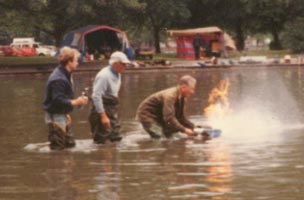 |
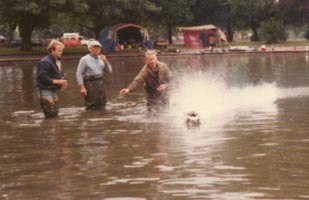 |
| Frank with TNT and lots of flames launching at South Cerney, and assisted by John and Rik Benson at Victoria Park | ||
|
|
Jim Bamford worked at the National Gas Turbine Research Establishment and both he and Frank spent a lot of time and effort on the flame tube and burner at the front of the boiler. Frank’s X1 was an ‘A’ Class boat in the same general style as ‘TNT’ but with a very long flame tube that extended just beyond the bow of the boat. There is a reference to Frank winning the ‘A’ Class at Blackheath in 1973 where there were three flash steamers present. In 1976 Frank won the Crebbin Cup again, just on thirty years after winning it for the first time. |
|
|
|
This boat is something of a mystery at present. It comes from late in Frank's career and uses the same plant as seen in X1 and the 'A' Class boat below. The hull seems to follow the TNT design and shows clearly how little prop is needed to make a boat run quickly. |
The next boat that there is a
record of came during Frank’s second association with
the Kingfisher Club, and is again believed to be an ‘A’ Class. The hull is now
more rectangular, both in cross section and plan, still with the extended drive
and two aluminium planing surfaces.
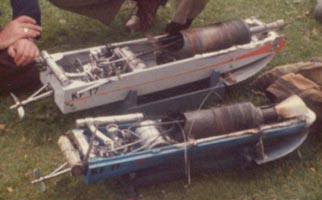 |
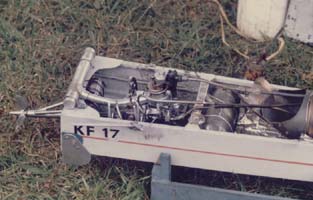 |
|
The motor is mounted nearer to the centre of the boat with the fuel tank inside the hull, rather than attached to the outside of the transom. The boiler is set well to the front of the hull and has a flame tube, which is extended even further so that it is now well in front of the bow. The question remains as to which 'A' Class hull came first, the rectangular one above or the semi circular one?
|
|
Sadly, Frank’s great friend and fellow flash steam experimenter, Jim Bamford died in 1984, so Frank was now competing against the new intake of steam exponents, led by Bob Kirtley and Ian Berne with their fresh thinking on hulls and steam plants. TNT was still unchallenged in the lighter ‘B’ Class, winning the Grand Regatta in 1985, but in the ‘A’ Class at the St Albans meeting Frank would finish second three years running. Something more up to date was required to achieve the speeds that Bob and Ian were reaching. Left: Frank at South Cerney in 1984 with TNT |
|
For the 1990 season, Frank appeared with new ‘A’ Class boat. This was entirely new in almost every respect, adopting all the latest design features being proved by Bob Kirtley and Ian Berne. The hull was a conventional three point outrigger hydro with the motor in the bow, driving a normal skeg mounted prop. The venturi boiler and single parallel flame tube was retained for a while but later abandoned in favour of a cylindrical boiler casing with three venturi flame tubes and three spider mounted primus nipples. |
|
This design combination would ultimately prove capable of being developed to exceed 120mph, but after running the boat at a few regattas, Frank decided to retire from the sport.
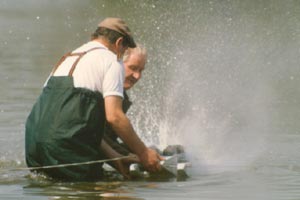 |
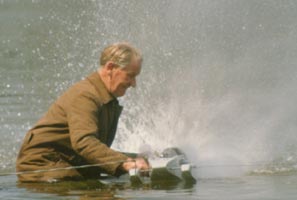 |
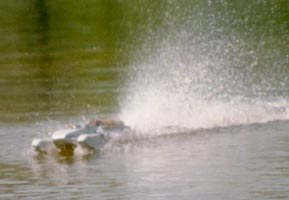 |
|
Frank, assisted by Ian Berne, launching his last 'A' Class boat in 1990 |
||
To be actively involved in tethered hydroplane racing for over fifty years is an achievement in itself, but to have spent the bulk of the time with flash steam shows an incredible level of determination and dedication. Frank Jutton’s name sits alongside the other great exponents of flash steam in the modern era and it has been a pleasure to put together this appreciation of his work and achievement.
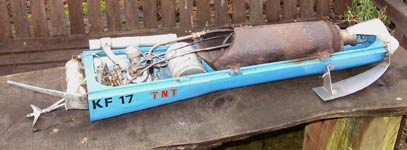 |
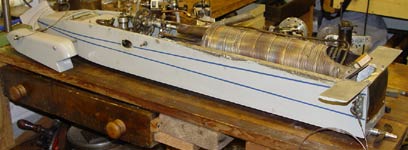 |
As related in an earlier article, 'TNT' was given to Olly Monk and now resides with him. Frank's last 'A' Class boat is now in the possession of Jim Bamford's son Rob and the hope is that it will be restored to running condition at some stage.
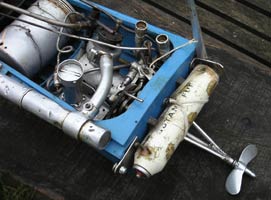 |
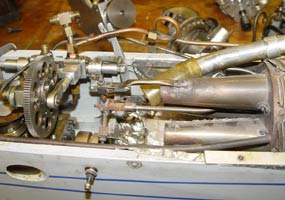 |
Our sincere thanks go to Frank and Mary Jutton and Loraine Batterbury for all the material they have supplied for these articles. To Tony Pilliner, Rob Bamford, Bob Kirtley, Jim Free, Terry Everitt and Olly Monk for photographs and information, and to Peter Hill for original photos from St Albans and providing regatta and trophy results.
©copyrightOTW2011